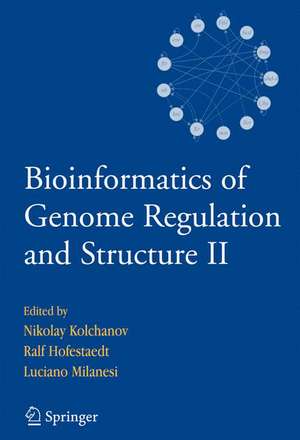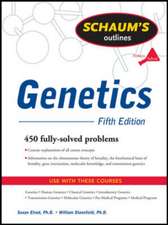Bioinformatics of Genome Regulation and Structure II
Editat de Nikolay Kolchanov, Ralf Hofestaedt, Luciano Milanesien Limba Engleză Hardback – 22 noi 2005
| Toate formatele și edițiile | Preț | Express |
|---|---|---|
| Paperback (1) | 957.75 lei 43-57 zile | |
| Springer Us – 4 dec 2014 | 957.75 lei 43-57 zile | |
| Hardback (1) | 963.91 lei 43-57 zile | |
| Springer Us – 22 noi 2005 | 963.91 lei 43-57 zile |
Preț: 963.91 lei
Preț vechi: 1175.51 lei
-18% Nou
Puncte Express: 1446
Preț estimativ în valută:
184.47€ • 191.88$ • 152.29£
184.47€ • 191.88$ • 152.29£
Carte tipărită la comandă
Livrare economică 14-28 aprilie
Preluare comenzi: 021 569.72.76
Specificații
ISBN-13: 9780387294506
ISBN-10: 0387294503
Pagini: 560
Ilustrații: XIV, 560 p.
Dimensiuni: 156 x 234 x 32 mm
Greutate: 0.98 kg
Ediția:2006
Editura: Springer Us
Colecția Springer
Locul publicării:New York, NY, United States
ISBN-10: 0387294503
Pagini: 560
Ilustrații: XIV, 560 p.
Dimensiuni: 156 x 234 x 32 mm
Greutate: 0.98 kg
Ediția:2006
Editura: Springer Us
Colecția Springer
Locul publicării:New York, NY, United States
Public țintă
ResearchDescriere
The last 15 years in development of biology were marked with accumulation of unprecedentedly huge arrays of experimental data. The information was amassed with exclusively high rates due to the advent of highly efficient experimental technologies that provided for high throughput genomic sequencing; of functional genomics technologies allowing investigation of expression dynamics of large groups of genes using expression DNA chips; of proteomics methods giving the possibility to analyze protein compositions of cells, tissues, and organs, assess the dynamics of the cell proteome, and reconstruct the networks of protein-protein interactions; and of metabolomics, in particular, high resolution mass spectrometry study of cell metabolites, and distribution of metabolic fluxes in the cells with a concurrent investigation of the dynamics of thousands metabolites in an individual cell. Analysis, comprehension, and use of the tremendous volumes of experimental data reflecting the intricate processes underlying the functioning of molecular genetic systems are unfeasible in principle without the systems approach and involvement of the state-of-the-art information and computer technologies and efficient mathematical methods for data analysis and simulation of biological systems and processes. The need in solving these problems initiated the birth of a new science— postgenomic bioinformatics or systems biology in silico.
Cuprins
Computational Structural, Functional and Evolutionary Genomics.- Recognition of Coding Regions in Genome Alignment.- Predicting sRNA Genes in the Genome of E. Coli by the Promoter-Search Algorithm PlatProm.- Content Sensors Based on Codon Structure and DNA Methylation for Gene Finding in Vertebrate Genomes.- The Sitega Tool for Recognition and Context Analysis of Transcription Factor Binding Sites: Significant Dinucleotide Features Besides the Canonical Consensus Exemplified By SF-1 Binding Site.- Transcription Regulatory Regions Database (TRRD): A Source of Experimentally Confirmed Data on Transcription Regulatory Regions of Eukaryotic Genes.- Artsite Database: Comparison of In Vitro Selected and Natural Binding Sites of Eukaryotic Transcription Factors.- Comparative Analysis of Electrostatic Patterns for Promoter and Nonpromoter DNA in E. Coli Genome.- Analysis of Nucleosome Formation Potential and Conformational Properties of Human J1-J2 and D2-D1 Type Alpha Satellite DNA.- VMM: A Variable Memory Markov Model Prediction of Nucleosome Formation Sites.- DNA Nucleosome Organization of the Promoter Gene Regions.- A Toolbox for Analysis of RNA Secondary Structure Based on Genetic Algorithm.- Comparative Genomics and Evolution of Bacterial Regulatory Systems.- Comparative Whole Genome Sequence Analysis of Corynebacteria.- New LTR Retrotransposable Elements from Eukaryotic Genomes.- A Genome-Wide Identification of Mitochondrial DNA Topoisomerase I in Arabidopsis.- Change in CpG Context is a Leading Cause of Correlation between the Rates of Non-Synonymous and Synonymous Substitutions in Rodents.- Universal Seven-Cluster Structure of Genome Fragment Distribution: Basic Symmetry in Triplet Frequencies.- New Methods to Infer DNA Function from Sequence Information.- Revelation and Classification of Dinucleotide Periodicity of Bacterial Genomes Using the Method of Information Decomposition.- Algorithms to Reconstruct Evolutionary Events at Molecular Level and Infer Species Phylogeny.- Computational Structural and Functional Proteomics.- Mining from Complete Proteomes to Identify Adhesins and Adhesin-Like Proteins: A Rapid Aid to Experimental Researchers.- Central Moments Based Statistical Analysis for the Determination of Functional Sites in Proteins with Thematics.- Amino Acids Surface Patterns in Protein Domain Functionality Analysis.- Computer Simulations of Anionic Unsaturated Lipid Bilayer—A Suitable Model to Study Membrane Interactions with A Cell-Penetrating Peptide.- The Role of Water in Homeodomain-DNA Interaction.- Molecular Modeling of Human MT1 and MT2 Melatonin Receptors.- Molecular Dynamics of Small Peptides Using Ergodic Trajectories.- A Periodical Nature of 94 Protein Families.- Prediction of Contact Numbers of Amino Acid Residues Using a Neural Network Model.- Fastprot: A Computational Workbench for Recognition of the Structural and Functional Determinants in Protein Tertiary Structures.- A Markov Model for Protein Sequences.- Proteome Complexity Measures Based on Counting of Domain-to-Protein Links for Replicative and Non-Replicative Domains.- Computational System Biology.- A Software Architecture for Developmental Modeling in Plants: The Computable Plant Project.- Prediction and Alignment of Metabolic Pathways.- General Principles of Organization and Laws of Functioning in Governing Gene Networks.- From Gradients to Stripes: A Logical Analysis of Drosophila Segmentation Genetic Network.- Self-Oscillations in Hypothetical Gene Networks.- Periodic Trajectories and Andronov-Hopf Bifurcations in Models of Gene Networks.- On the Problem of Search for Stationary Points in Regulatory Circuits of Gene Networks.- Modeling of Gene Expression by the Delay Equation.- AGNS—A Database on Expression of Arabidopsis Genes.- Study of the Interactions between Viral and Human Genomes During Transformation of B Cells with Epstein-Barr Virus.- Probing Gene Expression: Sequence-Specific Hybridization on Microarrays.- Determination of the Developmental Age of a Drosophila Embryo from Confocal Images of its Segmentation Gene Expression Patterns.- Biomolecular Data and Processes Analysis.- Topical Clustering of Biomedical Abstracts by Self-Organizing Maps.- Software for Analysis of Gene Regulatory Sequences by Knowledge Discovery Methods.- A Mathematical Model of the Discontinuous Genetic Structures Fixation Process.
Textul de pe ultima copertă
Bioinformatics of Genome Regulation and Structure presents selected papers from the Fourth International Conference on Bioinformatics of Genome Regulation and Structure (BGRS), held in Novosibirsk, Russia, in July 2004. The conference was organized by the Laboratory of Theoretical Genetics, Institute of Cytology and Genetics, Siberian Branch of the Russian Academy of Sciences, Novosibirsk, Russia. The material covers the most recent topics in bioinformatics, including (i) regulatory genomic sequences: databases, knowledge bases, computer analysis, modeling, and recognition; (ii) large-scale genome analysis and functional annotation; (iii) gene structure detection and prediction; (iv) comparative and evolutionary genomics; (v) computer analysis of genome polymorphism and evolution; computer analysis and modeling of transcription, splicing, and translation; structural computational biology: structure- function organization of genomic DNA, RNA, and proteins; (vi) gene networks, signal transduction pathways, and genetically controlled metabolic pathways: databases, knowledge bases, computer analysis, and modeling; principles of organization, operation, and evolution; (vii) data warehousing, knowledge discovery and data mining; and (viii) analysis of basic patterns of genome operation, organization, and evolution.
Bioinformatics of Genome Regulation and Structure will be useful for scientists involved in basic and applied research in the field of experimental and theoretical studies of structure-function organization of genomes, university teachers and students, and mathematicians and biologists.
Bioinformatics of Genome Regulation and Structure will be useful for scientists involved in basic and applied research in the field of experimental and theoretical studies of structure-function organization of genomes, university teachers and students, and mathematicians and biologists.
Caracteristici
Comprises the newest results obtained while researching into the structure and function of molecular genetic systems belonging to different complexity level of their organization
Covers the hottest items in bioinformatics
Includes supplementary material: sn.pub/extras
Covers the hottest items in bioinformatics
Includes supplementary material: sn.pub/extras











